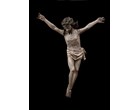 BACK TO GALLERY
BACK TO GALLERY
Eguiguren Arte de Hispanoamérica
"Aleijadinho" Antônio Francisco Lisboa
The Crucified Christ
110x89 cm - 43.3x45 in
description
Antônio Francisco Lisboa, called the Aleijadinho, is considered by consensus Brazil’s most important sculptor. He was born around 1730 or 1738 and died in 1814 in Vila Rica, Ouro Preto, Minas Gerais; the largest gold-mining center in Latin America. He was the son of the Portuguese architect Manuel Francisco Lisboa and an African slave named Isabel. He received his first drawing, sculpture and architecture lessons from his father but upon his death in 1767, he was not included in his will, as he was an illegitimate son. All his work is dedicated exclusively to religious themes and because of his inspiration, he reached the pinnacle of Brazilian sacred art. His representations of the crucified Christ carved in cedar are among the highlights of his oeuvre, being deeply dramatic, aesthetically refined and with a unique design in its execution.
Thus and despite the little access to education that his social condition imposed, his mastery compensated all these deficiencies and thanks to his creativity and a very strong will, he enjoyed an unusual fame and was considered in life as the New Praxiteles. Around 1770 he began to develop a series of degenerative diseases that slowly left him crippled, with loss of toes and fingers and extreme pains, hence his nickname "the Aleijadinho" -the cripple-. Despite this and with extraordinary willpower, he continued his artistic work in these extreme conditions and the last years of his life he lived in poverty and forgotten.
Among his masterpieces, we can mention the design of the Church of Saint Francis of Assisi in Ouro Preto, together with various carvings. The Basilica of the Good Jesus of Matosinhos, belonging to the Sanctuary of the Good Jesus of Matosinhos, presents in its atrium the unique group of the sculptures of the Twelve Prophets carved in soapstone between 1800 and 1805, endowed with masterful drama and originality. Previously, Aleijadinho and his workshop created sixty-six wood carvings referring to the Steps of the Passion, an extensive work carried out between 1796 and mid-1799. In 1985, UNESCO declared it a World Heritage Site.
Thus and despite the little access to education that his social condition imposed, his mastery compensated all these deficiencies and thanks to his creativity and a very strong will, he enjoyed an unusual fame and was considered in life as the New Praxiteles. Around 1770 he began to develop a series of degenerative diseases that slowly left him crippled, with loss of toes and fingers and extreme pains, hence his nickname "the Aleijadinho" -the cripple-. Despite this and with extraordinary willpower, he continued his artistic work in these extreme conditions and the last years of his life he lived in poverty and forgotten.
Among his masterpieces, we can mention the design of the Church of Saint Francis of Assisi in Ouro Preto, together with various carvings. The Basilica of the Good Jesus of Matosinhos, belonging to the Sanctuary of the Good Jesus of Matosinhos, presents in its atrium the unique group of the sculptures of the Twelve Prophets carved in soapstone between 1800 and 1805, endowed with masterful drama and originality. Previously, Aleijadinho and his workshop created sixty-six wood carvings referring to the Steps of the Passion, an extensive work carried out between 1796 and mid-1799. In 1985, UNESCO declared it a World Heritage Site.






 SEND AN EMAIL
SEND AN EMAIL